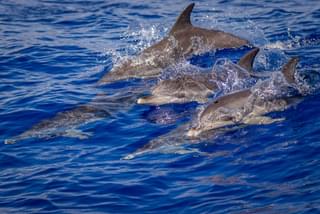Sowerby's beaked whale
.jpg?w=1400&h=600&q=85&auto=format&fit=crop&dm=1683137525&s=fed0d4e4e0f500a13f18932f7ab3ab54)
Mesoplodon bidens
4 - 5.5m
Scarring
Teeth
Dorsal fin
Soqweby's beaked whales have a small head with a prominent forehead and long beak; there is an indent before the blow hole. The adult male has a pair of triangular teeth midway down its beak on the lower jaw and scarring on the upper body. Females do not exhibit teeth or scarring. Sowerby's beaked whales have a curved dorsal fin set well back on their body. This species is a lot more slender than the Cuvier’s beaked whale and northern bottlenose whale and is more like an elongated dolphin in shape.
Key features:
- Long beak with small, rounded melon
- Curved dorsal fin situated , 2/3rds along the back
- Teeth located midway along the lower jaw in males
- Prominent beak breaks water surface first
Behaviour
Generally, Sowerby's beaked whales are very shy animals, so little is known about their behaviours. Most of the information we have about this species s is taken from strandings, as they are not commonly seen at sea. When seen, they are in groups of 1-10 individuals, usually 6 - 8, compromised of stable family groups. When surfacing, the long beak and melon appear first, with the back appearing whilst the head is still visible. The curved dorsal fin becomes visible as the animals smoothly roll through the water.
Threats
Threats include: marine pollutants (particularly plastic), entanglement in fishing gear, collision with ships, overfishing of prey species and climate change, as this can alter their habitat and the location of food.
Distribution
Most records of sightings have come from strandings around eastern North Atlantic. Most European sightings have occurred between the Canaries the Arctic Circle with the deep waters to the west of the UK and Ireland to be the centre of this species range. The few records we have suggest that it is the most frequently occurring Mesoplodon beaked whale in the North-west Atlantic.
.jpg?w=900&h=600&q=85&auto=format&fit=crop&dm=1683137525&s=4e3ed80fd2ad32f00895ead534626052)





Study whales and dolphins as an ORCA OceanWatcher
The ORCA OceanWatchers online training course, along with a bespoke app, will enable everyone to collect data about whales, dolphins and porpoises. And it can be collected from anywhere that you can see the sea - whether that’s from your local beach, on holiday at the coast, scanning the seas from a cruise ship, travelling via ferry, or from your own boat.
You may also be interested in



